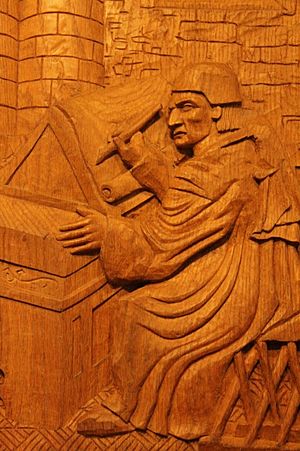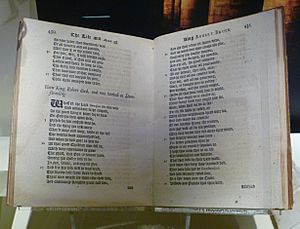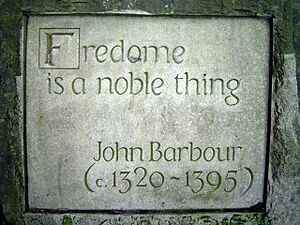John Barbour (poet) facts for kids
Quick facts for kids
John Barbour
|
|
|---|---|
 |
|
| Born | c. 1320 |
| Died | 13 March 1395 (aged c. 75) |
| Nationality | Scottish |
| Occupation | churchman and poet |
|
Notable work
|
The Brus |
John Barbour (born around 1320 – died March 13, 1395) was a famous Scottish poet. He was the first major writer known by name to write in the Scots language. His most important work that we still have today is a long poem called The Brus. This poem is about the Scottish hero, Robert the Bruce.
Because of The Brus, Barbour became very well-known. Some other long poems from that time are sometimes thought to be by him too. We know he wrote other works, like The Stewartis Oryginalle and The Brut, but these poems are now lost.
Barbour was a churchman, serving as an Archdeacon in the Diocese of Aberdeen in Scotland. He also studied at important universities like Oxford and Paris. Even though he worked for the church, his writings often focused on everyday life and history, not just religious topics.
His main supporter was King Robert II. It seems Barbour might have helped Robert II politically before he became king. John Barbour likely died in Aberdeen in 1395.
Contents
Barbour's Early Life and Career

John Barbour was probably born around 1320. We don't know exactly where he was born. Some people think it was in Aberdeenshire, while others suggest Galloway.
Barbour first appears in historical records in 1356. He became an archdeacon in Aberdeen. Before that, he worked in Dunkeld Cathedral for less than a year. It's thought that he might have visited Avignon in 1355.
In 1357, King David II returned to Scotland. Barbour received a special pass to travel through England to the University of Oxford. He seemed to leave Scotland often when David II was king.
Working for the King
After King David II died in 1371, Barbour worked for King Robert II. He had many different jobs in the royal court. During this time, he wrote his famous poem, The Brus.
In 1377, he received ten pounds Scots for his work on the poem. The next year, he was given a regular payment of twenty shillings for the rest of his life. He also held various positions in the king's household. For example, in 1372, he helped check the king's money records.
Barbour's Final Years
The last information we have about Barbour is from 1392. His signature appears as a witness on some documents in Aberdeen. According to the records of St Machar's Cathedral in Aberdeen, he died on March 13, 1395. After this date, his lifelong payment from the king stopped.
Barbour had arranged for a special church service to be held for himself and his parents. This service continued at St Machar's Cathedral until the Reformation.
Barbour's Major Works
About The Brus
The Brus is Barbour's most important poem that still exists. He wrote it in the 1370s while working for the king. The poem tells the story of Scotland's fight for independence. It focuses on Robert the Bruce and Sir James Douglas. The second half of the poem also talks about King Robert II's family, the Stewarts, and their part in the conflict.
Barbour wrote the poem to tell history and to show his love for Scotland. He praises Robert the Bruce and Douglas as brave and noble Scottish knights. The poem begins by describing Scotland after King Alexander III died in 1286. It ends with the death of Douglas and the burial of Bruce's heart in 1332. The most famous part of the poem describes the Battle of Bannockburn.
The poem has a strong sense of national pride. Robert the Bruce is shown as a hero, much like characters in other adventure stories of the time. The poem says that freedom is a "noble thing" that should be won at any cost. Those who fight against freedom are shown in a negative light.
Barbour's writing style in the poem is strong and lively. The lines flow well, and some parts are very powerful. The most famous lines are from Book 1, lines 225-228:
A! fredome is a noble thing!
Fredome mayss man to haiff liking;
Fredome all solace to man giffis:
He levys at ess that frely levys!
Lost Works: Stewartis Oryginalle
One of Barbour's known works that is now lost is The Stewartis Oryginalle. This poem was said to trace the family tree of the Stewarts. The Stewart family became the royal family of Scotland when Robert II became king. Robert II was Barbour's main supporter. We don't know why this important work was lost.
Possible Works: Buik of Alexander
Some people have suggested that Barbour also wrote The Buik of Alexander. This is a Scots translation of a French story called Roman d'Alexandre and other related pieces. This translation uses many ideas and phrases from The Brus. We know about it from a unique book printed in Edinburgh around 1580.
Possible Works: Legends of the Saints
Another possible work by Barbour is a very long Scots poem called Legends of the Saints. This poem has over 33,000 lines. It tells stories of saints, similar to those found in other old books like the Legenda Aurea. This poem was found in the library of the University of Cambridge.
The poem is similar to Barbour's known work in its length, dialect, and style. It also leaves out stories of English saints and includes stories of St. Machar (the patron saint of Aberdeen) and St. Ninian. This makes it seem likely that Barbour wrote it. However, some experts disagree, based on how the rhymes and words are used.
Barbour's Lasting Impact
John Barbour is often called the "father" of Scots poetry. He holds a similar place in Scottish literature as Chaucer does in English literature. Chaucer was a writer from England who lived a bit later than Barbour.
If Barbour truly wrote all the long poems that some people say he did, he would be one of the most productive Scots poets ever. But even with just The Brus, he is very important. This poem was new because it used the style of chivalric stories to tell a historical tale. It also tells a powerful story of fighting against unfair rule. Barbour was an important and creative writer who helped shape the Scots language in literature.
See also
 In Spanish: John Barbour para niños
In Spanish: John Barbour para niños




